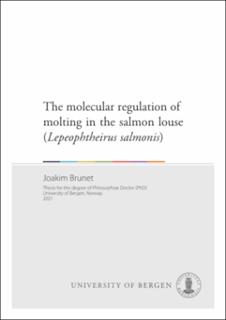| dc.description.abstract | The salmon louse, Lepeophtheirus salmonis, is a copepod and an ectoparasite that infects salmonids in the Northern hemisphere. At present, salmon louse infestations are the biggest threat to the health and welfare of wild and farmed fish, causing huge financial losses to the salmon farming industry annually. Salmon louse infestations are predominantly controlled using chemotherapeutants, however, extensive use has resulted in widespread resistance. Non-chemical methods such as freshwater treatment, cleaner fish, and lice skirts have been introduced, but there is a need for novel treatment methods as the non-chemical methods are not sufficient. More knowledge of salmon louse biology can be the key for developing new chemotherapeutants and finding new treatment targets.
Molting is a critical aspect of arthropod physiology, a process where the animal replaces the cuticle for a larger one to allow for further growth. The timing of molting is controlled by a class of arthropod steroid hormones known as ecdysteroids. In insects, pulses of the ecdysteroid 20-hydroxycedysone (20E) controls molting by binding and activating the nuclear receptor dimer complex consisting of the ecdysone receptor (EcR) and Ultraspiracle (Usp). Once activated the EcR/Usp receptor complex initiates a transcriptional cascade consisting of a selection of ecdysteroid regulated transcription factors that regulate the gene networks controlling molting. Feed-forward and feedback loops in the ecdysteroid induced transcriptional cascade ensures that the transcription factors are expressed in a specific sequential order and temporal window. Manipulation of this cascade results in molting arrest and developmental defects in the arthropod species studied. The molecular mechanisms regulating the ecdysteroid induced transcriptional hierarchy have been extensively studied in insects, but little is known about the molecular regulation of these transcription factors in copepods and crustaceans in general. For this purpose, the goal of the study was to expand the knowledge of the ecdysone endocrine system in the salmon louse.
While 20E is the main regulator of molting in insects, both 20E and the ecdysteroid Ponasterone A (PonA) have been shown to have physiological activity in crustaceans. In the current study, it was demonstrated through the implementation of a two-hybrid reporter gene assay and in vivo exposure of nauplii to ecdysteroids, that PonA is the ligand for the salmon louse ecdysone receptor complex, and that 20E apparently has little physiological activity in the salmon louse. The gene expression of the transcription factors Hormone Receptor 3 (HR3), Hormone Receptor 4 (HR4), Ecdysone-inducible Protein 74 (E74), Ecdysone-inducible Protein 75 (E75), and Fushi Tarazu Factor-1 (FTZ-F1), together with ecdysteroid hormone levels, were measured in high resolution through the pre-adult I and nauplius II molt cycle. These ecdysteroid regulated transcription factors displayed specific temporal expression profiles relating to levels of ecdysteroid hormones. Manipulation of the natural expression profiles of the ecdysteroid regulated factors with PonA revealed that HR3 and HR4 are early response genes to increased levels of PonA, while increases in E74, FTZ-F1 and E75 expression appear to be secondary and tertiary responses to high levels of PonA. Quantification of PonA across a molt cycle revealed, similar to observations from other arthropods, that a drop in ecdysteroid treatment precedes ecdysis. Treatment with PonA within the nauplius II stage resulted in molting arrest, indicating that a drop of hormone levels is required to initiate ecdysis.
The nuclear receptor FTZ-F1 has been shown to be crucial in the regulation of molting in both insects and nematodes, but its function has never been characterized in crustaceans. Molecular cloning of the FTZ-F1 gene in the salmon louse revealed that it encodes two nuclear receptor isoforms with unique N-terminal domains, generated by alternative promotor usage and splicing. Re-analysis of available FTZ-F1 sequences in ecdysozoans suggests that the FTZ-F1 gene structure to produce two N-terminal isoforms is conserved in all subphyla apart from nematodes. Knockdown of the two FTZ-F1 isoforms, αFTZ-F1 and βFTZ-F1, revealed that βFTZ-F1 is an important regulator of both molting and oocyte development in the salmon louse. Knockdown of βFTZ-F1 in nauplii and pre-adult I resulted in molting arrest, while knockdown in pre-adult II females resulted in the destruction of oocytes at the vitellogenic stage in adult females. Transcriptome sequencing and differential gene expression analysis suggest that βFTZ-F1 regulates processes involving cuticle detachment and ecdysis.
Combined, the results expand the current knowledge of how ecdysteroid signalling regulates molting in the salmon louse. Increased knowledge of the endocrine control of molting in the salmon louse can provide the basis for the discovery of new chemotherapeutants to control salmon lice infestations. | en_US |
| dc.relation.haspart | Paper I: Brunet. J, Tolås. I, Eichner. C, Dulgheriu. D, Horsberg. T.E, Male. R. (2021). The ecdysteroid Ponasterone A serves as the major regulator of molting in the salmon louse, an ectoparasitic crustacean (Lepeophtheirus salmonis). The article is not available in BORA. | en_US |
